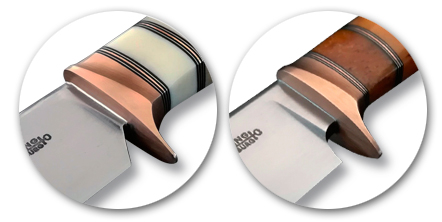I make all my knives by hand, a belt grinder is only used for the basic sharpening, everything else is done with files, emery paper and a lot of patience.
With the exception of the "Town & Country", "Al Naif" and the "Aficionado" I make all my knives with a hidden tang, because this design allows more freedom in designing the handle, is light and yet very stable.
I avoid any abrupt changes in the thickness of the tang and the shoulders on which the handguard rests are rounded. The tang taperes continuously from the ricasso to the end.
The planning
Each knife begins with a drawing to visualize proportions and how the liners relate to the rest of the handle. The shape of the blade is selected according to the requirements, the length of the handle according to the size of the hand.
I mostly use tool or roller bearing steels such as 1.3505, 1.2442, 80CrV2 or Damascus steel from Achim Wirtz and Norbert Bahls. M390 or 1.4220-02 / QPM20-4 or N690 is used as stainless steel.
As a blade grind, I prefer a flat grind that has a finer or stronger bevel, depending on use.
Proportions
I believe the ricasso should be the same width as the ferrule just below the handguard, if the ferrule is narrower the proportions will be wrong, as will if the handle is below the backline.
The shapes and lines of the blade should continue into the handle to make it look straight out of one shot.
The ricasso
The ricasso is the unsharpened area of the blade above the handguard. I like to finish this area with a distinctly free edge as this makes sharpening easier and the edge shape stays the same even after years of sharpening without exhibiting an S-shape. When choosing the different shapes, the use must be taken into account, so the cutting edge should be as long as possible and located close to the hand guard, on the other hand, with hunting knives in particular, the cutting edge should be prevented from getting caught. Under certain circumstances, this area can be several centimeters long in order to make it possible to grasp the blade briefly

Handguard
The handguard has a slight edge on the front as a design element that works as a haptic guide, so that you know blindly how you are holding the knife. The handguard is brazed with 6% Ag solder, which melts at 230ºC and matches the tempering temperature of the steel, so the hardness is not affected. Nevertheless, I protect the blade from heat with a damp cloth when soldering. A soldered handguard guarantees a hermetically sealed grip. For some constructions, such as a puddle iron handguard, this is fitted to perfection and epoxy bonded since the solder would contaminate the structure of the iron.

The handguard can be made of brass, iron, steel, nickel silver or bronze. Gunmetal gets a brownish-red patina, phosphor bronze as CuSn8 or CuSn6, with the CuSn6 also getting a darker patina, absolutely corrosion-resistant for lovers of the sea, also aluminum bronze.
The pommel
I usually build the knives with a handle made of 2-3mm bronze, brass, iron, buffalo, silver or with inlays made of mammoth ivory or buffalo. With hunting knives, a cartridge case from an important hunt or the preferred caliber can also be inserted.
